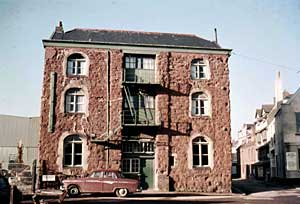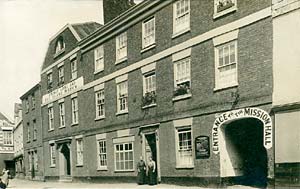
Exeter Stories
Exeter folk and friends in their own words - 1890's to the 1990's │ << Previous story │ Next story >> │
Peter Hinchliffe - smelly old Exeter
Exe Island and Shilhay
At the start of the 20th Century most of the commercial activity was concentrated about the Exe Bridge, I suppose the close proximity of the water and the several leats cut from the river were the original attraction. The plain on the east bank was full of industry. Starting at the Head Weir was Pims Paper Mill in Bonhay Road, opposite at the bottom of Exe Street was another large factory building beside the leat, in 1960 it was occupied by a Tyre Company, where Powhay House now stands was an Ice factory.
In Tudor Street there was a great variety of industry. One company made electric motors, it was the site of the slaughterhouse, Parkins had their foundry and steel stockholding yards, there was a builders merchants, and several builders yards.
The Exe Island 'doss house'
Originally at the end of Tudor Street, more or less where the Queen Victoria pub still is, the was a triangular open space, which was known as Exe Island. Overlooking the Island was a common lodging house or “spike” which is now best described as a sleeping place for vagrants, run by Dave Dewar. There was another at 2 Haven Road run by the Council.
When I was a boy we wrongly believed these two places to be the workhouse, later when visiting them as a policeman, I discovered that they were probably not as hospitable as the workhouse would have been!
At the top of the building, in the attic, was the “rope”, allegedly this is where those men without the few pence fee to sleep on a bed could drape themselves over the rope for a nights rest. Some would argue that the expression “on the ropes” originated from this source, i.e. they had so little money that they could not afford the cheapest bed, they were obliged to sleep on the rope.
Strategically placed, next door to the “spike” was the City Council decontamination facility, where people and household goods, could be cleansed of whatever infested them.
From Frog Street to Commercial Road
Until the new Frog Street was built, Exe Island was always the site of the biggest bonfire on Guy Fawkes night. Under the old Frog Street Bridge where further business premises, the City brewery was on the right, and Taylors coach garage on the left, at the end of this street was the House that Moved.
In Edmund Street there was further industry, there was Tremletts Tannery and the mills in Cricklepit Street beside the Teignmouth Inn. At the junction of Edmund Street and Commercial Road, right on the river bank was a modern brick built edifice which housed Jourdans box factory. South along Commercial Road was J L Thomas who were rendering down offal, bones, and other waste, a little further along was a firm called Oppenheimer, who seemed to be in a competition with Thomas to see who could create the most offensive smell.
A days police duty on Exe Bridge beat on a sultry day with no wind, was not for the feint hearted. The stench of brewing mixed with tanning, flavoured by cooking offal, could put a weak man off his food.
To think there were houses in Commercial Road jammed in between Thomas’ and the Tannery!
Another treat for the citizens in that area happened every day but Sunday, shortly after 6am. The sewer system in Exe Island had not been designed for the use it was having. So every morning, Bert Fowler and his men, opened the sewers in Tudor Street and Frog Street. They had large metal cones which they pulled through the sections between the manholes. Imagine, if you can, the smell. The prevailing wind scented the whole of Fore Street and the bottom end of the town. The problem went with the new road lay out at Frog Street Bridge’
The Pyramids Swimming Pool
The facility was opened just before the Second World War and was the finest Swimming Pool in the West Country, it was years in front of all the rest, as a competitive swimmer and water polo player from the 40s to 60s, I can tell you we never went to a better pool.
I had learnt to swim by the time I was six, and my parents allowed me to go, alone, to the Baths from that age on. I spent my formative years as a member of the Exeter Swimming Club. In fact my love of swimming was very far reaching, it shaped my whole future, including a career in the Police.
The Swimming Baths, until the early sixties, were not only a leisure facility, they were an important feature in the cleanliness of the City. It was possible to go there for a “slipper bath”, the quaint name the council gave to washing oneself whilst sitting in a bath tub. Many people in those days had no alternative if they wanted a bath.
I recall that whilst we were swimming up and down in the pool, a queue of men, (and the occasional woman) would be standing on the balcony to await their turn in a hot tub, each holding their Council issued towel and soap.
The queues were usually longest at the weekend, echoing the old song “Friday night is bath night, doo dah” Sometimes if the waiting time for a slipper bath was too long, men would take the colder option and shower, with copious soap, in the swimming pool entrance.
The Manager of the pool was Joe Woods, a Lancastrian, he had swum and played water polo for Everton Gap SC, who were, and still are, on of the leading clubs in the country. He had a collection of men;s swimming costumes, the type that at one time you could hire from the Council. These were all one piece costumes with shoulder straps, most of them emblazoned with “Hired from the Corporation”, “Exeter City Council” “on hire” and the like. When Joe retired he gave them to me, they were featured at the opening of several swimming pools around Devon in the 1960s, sadly they are no more.
More Hygiene
They say cleanliness is next to Godliness, and over the centuries there has been plenty of Godliness in the city with countless churches. The City was also fairly generous with their provision of cleanliness. There was a wash-house in Rack Street where people could take their clothes and household dirty linen to wash, almost in public. I do not know when this facility closed. The building was still there in the late 50s.
The council swimming baths at Heavitree Road, Pyramids, used to offer “Slipper baths”, where the public could, for 15 minutes wallow in soap and water, in their own cubicle. I well remember the waiting queue of people on the balcony of the swimming pool, standing there with their towels and soap which had been supplied at the ticket office. Waiting for their turn to get clean.
A “wash and brush up” service was on offer every day of the year, yes, including Christmas day. The public could get a wash, shave, and clean up for a few pence, the council supplying the towel and soap. You could also borrow a razor of the attendant. The Exe Bridge service was popular with workmen. In Exeter there were three, serving both men and women, separately of course, they were open every day of the year from 6 a.m. to 10p.m. including Christmas Day! The service offered the client the chance to wash themselves with soap and towel provided, at a charge. One of the staff at Catherine Street in the 60s was a chap called “Tich Newman” who had been a professional footballer in the First and Second Divisions, before playing for Exeter City in the twilight of his career. I can’t imagine any of today’s footballers doing the same job.
The three sites in Exeter were at Exe Bridge, a subterranean Lavatory actually in Commercial Road, and part of the granite architecture of the 1905 bridge. The second was at Maddocks Row, a pathway between the top two parks of the Paul Street Bus and Coach Station. The third was in the City Centre behind St Stephens Church in Catherine Street, these subterranean lavatories still exist.
There was one character who used this facility every day, a Coal Merchant called Jimmy Bee, long deceased, a lovely fellow with a physique that comes of carrying sacks of coal for a livelihood. Jim had a store for his lorry in Commercial Road. At the end of the day he would go for a strip wash, like a pit head bath for a coal miner, before getting changed from his soiled clothes and going home clean.
Until the new Exbridges were constructed, there was a heavy lorry parking area in the old cattle market in Bonhay Road. Many of these drivers availed themselves of the facilities at the Exe Bridge Toilets. It was not unusual, as a beat PC to go into the Wash and Brush up area and find a man completely stripped, having what was really a shower, except he was throwing the water over himself.
© 2007 Peter Hinchliffe
Peter Hinchliffe is a retired police officer.
 The Exe Island doss house
The Exe Island doss house
 Entrance to the Exe Island Mission -
the building, down the passage, is now the Plumb-In Centre
Entrance to the Exe Island Mission -
the building, down the passage, is now the Plumb-In Centre
│ Top of Page │